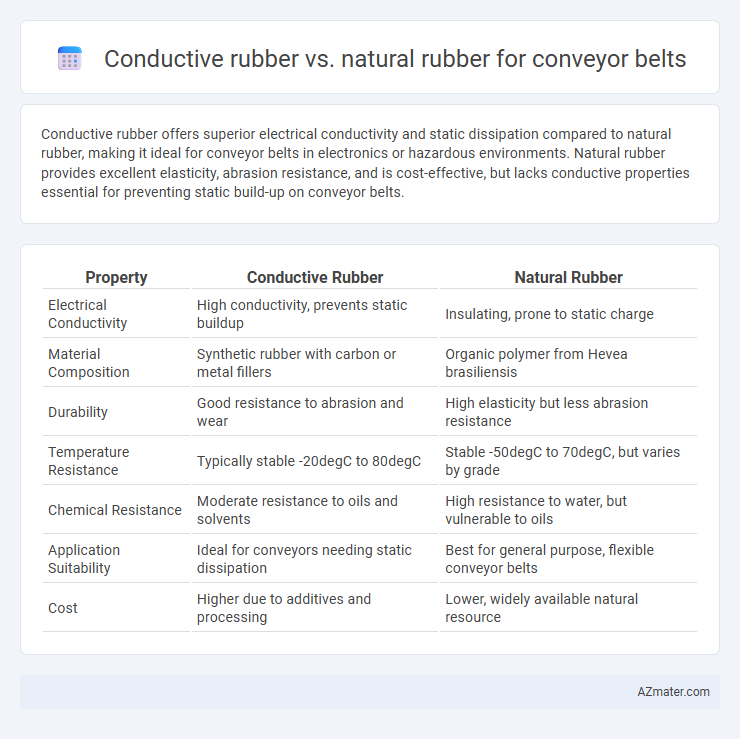Conductive rubber offers superior electrical conductivity and static dissipation compared to natural rubber, making it ideal for conveyor belts in electronics or hazardous environments. Natural rubber provides excellent elasticity, abrasion resistance, and is cost-effective, but lacks conductive properties essential for preventing static build-up on conveyor belts.
Table of Comparison
| Property | Conductive Rubber | Natural Rubber |
|---|---|---|
| Electrical Conductivity | High conductivity, prevents static buildup | Insulating, prone to static charge |
| Material Composition | Synthetic rubber with carbon or metal fillers | Organic polymer from Hevea brasiliensis |
| Durability | Good resistance to abrasion and wear | High elasticity but less abrasion resistance |
| Temperature Resistance | Typically stable -20degC to 80degC | Stable -50degC to 70degC, but varies by grade |
| Chemical Resistance | Moderate resistance to oils and solvents | High resistance to water, but vulnerable to oils |
| Application Suitability | Ideal for conveyors needing static dissipation | Best for general purpose, flexible conveyor belts |
| Cost | Higher due to additives and processing | Lower, widely available natural resource |
Introduction to Conveyor Belt Materials
Conductive rubber and natural rubber serve distinct roles in conveyor belt applications, with conductive rubber offering essential antistatic properties to prevent static build-up and potential hazards in environments handling flammable materials. Natural rubber provides superior elasticity, tensile strength, and abrasion resistance, making it ideal for heavy-duty conveyor systems requiring durability and flexibility. Understanding the material properties of conductive and natural rubber is crucial for selecting conveyor belts that meet specific industrial safety and performance requirements.
Overview of Conductive Rubber
Conductive rubber used in conveyor belts offers enhanced electrical conductivity, improving safety by dissipating static electricity and preventing sparks in volatile environments. This material typically incorporates carbon black or metal particles to achieve its conductive properties while maintaining elasticity and durability. Its application in conveyor belts is critical in industries prone to explosion hazards, such as mining and chemical processing, where static control is essential.
Overview of Natural Rubber
Natural rubber, harvested from the latex of rubber trees, offers excellent elasticity, tensile strength, and abrasion resistance, making it a popular choice in conveyor belts subjected to high stress and heavy loads. Its inherent flexibility and resilience enable superior grip and cushioning, essential for efficient material handling in industries like mining and agriculture. Although natural rubber is less conductive and more vulnerable to environmental degradation than conductive rubber, its cost-effectiveness and mechanical properties often make it the preferred material for conveyor belt covers.
Key Material Properties Comparison
Conductive rubber offers superior electrical conductivity and anti-static properties essential for conveyor belts in environments requiring static discharge prevention, unlike natural rubber which lacks inherent conductivity. Natural rubber provides excellent elasticity, tensile strength, and abrasion resistance, making it suitable for general-purpose conveyor belts with high mechanical demands. The key distinction lies in conductive rubber's ability to dissipate static electricity while maintaining flexibility, whereas natural rubber excels in resilience but requires additives or treatments to achieve conductivity.
Electrical Conductivity and Safety
Conductive rubber conveyor belts incorporate carbon black or metal particles to enhance electrical conductivity, effectively dissipating static electricity and reducing the risk of sparks in hazardous environments. Natural rubber, while offering excellent mechanical properties and flexibility, lacks inherent conductivity and can accumulate static charges, posing safety hazards in explosive or flammable material handling. Selecting conductive rubber improves workplace safety by minimizing electrostatic discharge, ensuring compliance with industrial safety standards in conveyor applications.
Durability and Wear Resistance
Conductive rubber conveyor belts offer enhanced durability and superior wear resistance due to their carbon-based conductive fillers, which improve mechanical properties and reduce static buildup. Natural rubber, while flexible and resilient, tends to have lower abrasion resistance and degrades faster under continuous friction and harsh operational environments. Choosing conductive rubber increases conveyor belt lifespan and performance in industrial applications requiring high durability and minimal wear.
Performance in Industrial Environments
Conductive rubber offers superior static dissipation and electrical conductivity compared to natural rubber, making it ideal for conveyor belts in environments with flammable materials or sensitive electronic components. Natural rubber excels in flexibility and abrasion resistance but lacks the conductivity needed to prevent electrostatic buildup, which can cause hazards or equipment malfunction. Industrial settings requiring anti-static properties and enhanced safety standards benefit significantly from conductive rubber's performance advantages.
Cost Considerations
Conductive rubber conveyor belts typically incur higher initial costs than natural rubber due to specialized materials enhancing electrical conductivity and safety in explosive environments. Natural rubber offers a cost-effective solution with excellent elasticity and abrasion resistance but lacks inherent conductivity, potentially increasing risk in static-prone applications. Maintenance expenses also differ, with conductive rubber requiring more frequent inspections and replacements to maintain performance compliance, impacting long-term operational budgets.
Environmental Impact and Sustainability
Conductive rubber used in conveyor belts often contains synthetic additives and carbon black, which can hinder biodegradability and pose environmental challenges in disposal, whereas natural rubber is renewable and biodegradable, offering a more sustainable option. The production of natural rubber relies on rubber tree plantations that absorb CO2, promoting carbon sequestration, whereas conductive rubber manufacturing typically involves petrochemical processes with higher carbon footprints. Recycling conductive rubber conveyor belts is more complex due to mixed material composition, while natural rubber belts have more established recycling methods, contributing to lower environmental impact over their lifecycle.
Choosing the Right Rubber for Conveyor Belts
Selecting the right rubber for conveyor belts depends on the application's specific requirements; conductive rubber offers excellent static dissipation properties, making it ideal for environments where electrostatic discharge poses a risk. Natural rubber provides superior abrasion resistance and elasticity, ensuring durability in heavy-load and high-impact scenarios. Evaluating factors like operational environment, safety standards, and mechanical stress is crucial to determine whether conductive or natural rubber best suits conveyor belt performance and longevity.

Infographic: Conductive rubber vs Natural rubber for Conveyor belt
 azmater.com
azmater.com